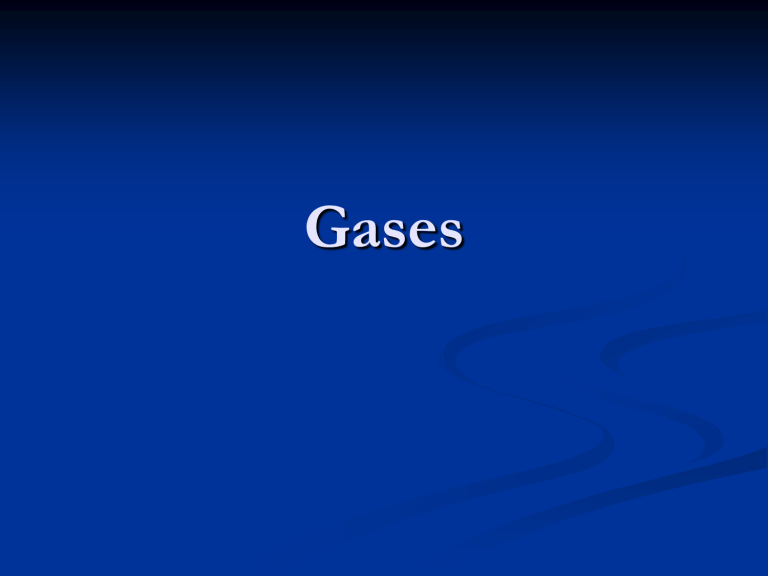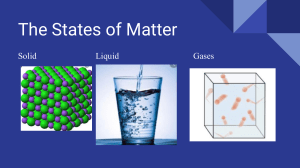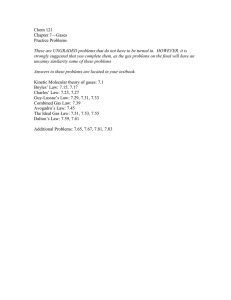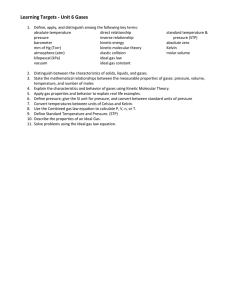
Gases Gases The forces of attraction between gas molecules are very small Each molecule moves randomly; Each molecule moves freely and essentially independently of other molecules. gas and vapor Gases-the molecules are relatively far apart A gas expands spontaneously to fill its container. the volume of a gas equals the volume of its container. Gases also are highly compressible: When pressure is applied to a gas, its volume readily decreases. Two or more gases form a homogeneous mixture regardless of the identities or relative proportions of the gases Pressure of a gas SI unit of pressure: Pascal (Pa) 1 Pa = 1 N/m2 Barometer: measuring the atmospheric pressure. Standard atmospheric pressure: 1 atm = 760 mmHg =760 torr = 101,325 Pa =101.325 kPa = 1.01325 bar Manometer: measuring the pressure of gases other than the atmospheric The gas laws Boyle’s law Charles’s and Gay-Lussac’s law, or simply Charles’s law Avogadro’s law The gas laws: Boyle’s law PV = k, (一定量气体,恒T) The volume of a fixed quantity of gas maintained at constant temperature is inversely proportional to the pressure. P1V1=P2V2 The gas laws: Boyle’s law A sample of N2 has a volume of 1.5 L at a pressure of 600 torr. Calculate the volume of the gas if the pressure is changed to 760 torr at a constant temperature. The gas laws: Charles’s law (Charles’s and Gay-Lussac’s law) V =bT (一定量气体,恒P) The volume of a fixed amount of gas maintained at constant pressure is directly proportional to its absolute temperature. Absolute zero on the Kelvin scale: 0 K = -273℃ V1 V2 = T1 T2 10 ℃ = ? K The gas laws: Avogadro’s principle Volume (V) and moles (n):V = k n(恒温恒压) The volume of a gas maintained at constant temperature and pressure is directly proportional to the number of moles of the gas. V1 = V2 n1 n2 The ideal gas law An ideal gas: (a) the molecules of an ideal gas do not interact with one another (b) the combined volume of the molecules is much smaller than the volume the gas occupies; for this reason, we consider the molecules as taking up no space in the container. The ideal gas law The ideal gas equation: PV = nRT R : gas constant, 0.0821 L atm mol-1 K-1, or 8.314 m3 Pa mol-1 K-1 T: K standard temperature and pressure (STP): 0℃ and 1atm At STP, molar volume of a gas = 22.4 L Gas Densities(d) and Molar Mass(M) Questions : The density of a gas is 3.38 g/L at 40 ℃ and 1.97 atm. What is its molar mass? Exercise (A) (B) (C) (D) (E) What is the density of a gas at 76 torr and 37℃ (molar mass = 25 g/mol) 0.1 g/L 0.8 g/L 22.4 g/L 75 g/L 633 g/L A Gas stoichiometry Gas mixtures and partial pressure The total pressure of a mixture of gases equals the sum of the pressures that each would exert if it were present alone. The pressure exerted by a particular component of a mixture of gases is called the partial pressure of that component. Dalton’s law of partial pressures Ptotal = P1 + P2 + … partial pressure The mole fraction: Xi= ni/ntotal Pi= XiPtotal Dalton’s law of partial pressures A mixture of gases contains 2.00 mol of O2, 3.00 mol of N2, and 5.00 mol of He, the total pressure of the mixture is 850 torr. What is the partial pressure of each gas? Exercise (A) Boyle’s law (B) Charles’s law (C) Avogadro’s law (D) Ideal gas law (E) Dalton’s law 1. Total pressure of a gaseous mix is equal to the sum of the partial pressure. 2. Volume is inversely proportional to pressure. 3. Volume is directly proportional to temperature 4. All gases have the same number of moles in the same volume at constant temperature and pressure Oxygen gas generated by the decomposition of potassium chlorate is collected. The volume of oxygen collected at 24°C and atmospheric pressure of 762 mmHg is 128 mL. Calculate the mass (in grams) of oxygen gas obtained. The pressure of the water vapor at 24°C is 22.4 mmHg. The kinetic molecular theory of gases 5 assumptions: The volume occupied by the atoms or molecules in a gas is negligibly small. The attractive or repulsive forces between the atoms or molecules in a gas are negligible. Gases consist of molecules or atoms in continuous random motion. Collision between these molecules or atoms in a gas are elastic. The average kinetic energy of a molecule or atom in a gas is directly proportional to the Kelvin temperature of the gas. Any two gases at the same temperature will have the same average kinetic energy. The kinetic molecular theory of gases Distribution of molecular speed (one gas at different temperature) the peak of the curve represents the most probable speed, ump root-mean square (rms) speed, urms, of the molecules: the speed of a molecule possessing a kinetic energy identical to the average kinetic energy of the sample. The rms speed is not quite the same as the average speed, uav. The kinetic molecular theory of gases Distribution of molecular speed (different gases at T) The kinetic molecular theory of gases One of the results of the kinetic theory of gases is that the total kinetic energy of a mole of any gas equals 3/2RT. Root -mean- square speed (urms): 3RT urms M The most probable speed of a gas molecule: Gas diffusion and effusion : effusion, which is the escape of gas molecules through a tiny hole diffusion, which is the spread of one substance throughout a space or throughout a second substance. Graham’s law: rates of effusion of the two gases are r1 and r2 and molar masses are ℳ1 and ℳ2 Gas diffusion and effusion : Question: He leaks through a very small hole into a vacuum at a rate of 3.22×10-5 m/s , how fast will O2 effuse through the same hole under the same conditions? Deviation from ideal behavior Real gases At low temperature and/or high pressure, the distances between the particles decrease dramatically, the real volumes and forces can no longer be ignored. Deviation from ideal behavior Real molecules, however, do have finite volumes and do attract one another van der Waals equation: (P+an2/V2)(V-bn) = nRT (P+an2/V2)(V-bn) = nRT C A A E (A) (B) (C) (D) When a gas is collected over water, the pressure is corrected by Adding the vapor pressure of water Multiplying by the vapor pressure of water Subtracting the vapor pressure of water at that temperature Subtracting the temperature of the water from the vapor pressure. C






